Exploring the Benefits and Structure of Stud Frame Walls
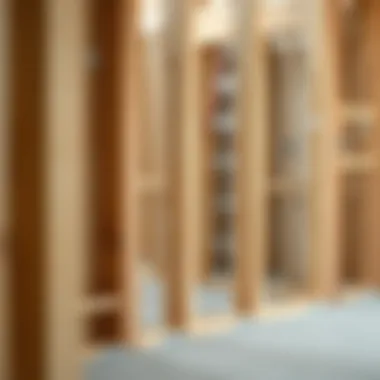

Intro
In the landscape of modern construction, stud frame walls have carved out a niche that reflects both innovation and tradition. These walls offer a seamless blend of durability, energy efficiency, and aesthetic flexibility, making them the go-to choice for many builders and architects. By dissecting the structure and benefits of stud frame walls, we can unveil the underlying principles that make them crucial in residential and commercial projects.
Stud frame walls are primarily characterized by their framework of vertical wooden or metal studs, which are spaced evenly and typically covered with sheets of drywall or similar materials. This seemingly simple structure holds profound implications for building design, energy conservation, and overall to functionality.
As we delve deeper into this subject, it becomes apparent how vital it is for architects, builders, and prospective homeowners alike to grasp not just the 'how,' but also the 'why' behind these walls. The construction realm is laden with choices, however, stud frame construction stands out for its adaptability to various design styles, which we will explore in the sections to follow.
Foreword to Stud Frame Walls
Stud frame walls have become a prevalent choice in both residential and commercial construction, and understanding their structure is essential for several reasons. First and foremost, these walls offer a balance of durability and design flexibility, which is invaluable when working on various architectural projects. Moreover, they adapt well to energy efficiency needs, a crucial aspect in today’s environmentally-conscious building practices. The aesthetic potential of stud frame walls also merits discussion, as they allow for open and creative design possibilities for spaces.
Definition and Overview
In straightforward terms, stud frame walls consist of vertical studs, typically made from wood or metal, which are joined together by horizontal members. These horizontal pieces, known as top and bottom plates, provide stability to the framework. Sheathing materials are often added to give the walls structural integrity and insulation. The beauty of stud frame construction lies in its simplicity yet robust nature; it provides a canvas for countless design approaches, from minimalist to elaborate styles. The use of different materials for sheathing and insulation opens the door for various performance characteristics, enhancing energy efficiency and sound control.
Historical Context
The roots of stud frame wall construction can be traced back to ancient building techniques where wooden frameworks were utilized for strength and resilience. As we moved into the 19th century, the advent of new technologies transformed this construction method. The availability of industrial-grade lumber and innovations in manufacturing processes expedited its popularity, particularly in the United States during the post-war era. This was a time when fast and efficient building solutions were needed to accommodate the booming population and expanding suburbs.
Fast forward to today, stud frame walls are not merely a throwback to earlier times but rather an evolutionary stage of construction that combines traditional methods with modern advancements. It’s fascinating to note how builders and architects have consistently found ways to innovate with this technique, embracing materials that improve thermal performance and sustainability. This historical evolution showcases not just a method of construction but a narrative of adaptation and ingenuity in the face of changing societal needs.
"Understanding the history of stud frame walls gives context to their ongoing relevance in modern architecture."
In summary, the significance of stud frame walls extends beyond their mere definition. They encapsulate a blend of historical significance, practical utility, and contemporary design, making them a cornerstone of modern construction practices.
Components of Stud Frame Walls
In order to grasp the full significance of stud frame walls, one must take a closer look at their key components. The effectiveness and reliability of these walls in construction rely heavily on elements like vertical studs, top and bottom plates, sheathing materials, and insulation choices. Each part plays a crucial role not only in the structural soundness but also in the energy efficiency and overall utility of the wall system. Understanding these components enables architects and builders alike to make informed decisions, ensuring durability and design flexibility across different construction projects.
Vertical Studs
Vertical studs are the backbone of stud frame walls. These wooden or metal columns stand vertically and help support the structure. Their distance apart usually ranges from 16 to 24 inches on center, and this spacing dictates how much weight the wall can bear. These studs must be sturdily anchored to the floor and ceiling plates for optimal performance.
The importance of vertical studs also extends to functionality. They provide pathways for electrical and plumbing installations, making it easier to access services and utilities within the wall space. Moreover, when finished correctly, they contribute to a clean aesthetic, which is an important factor in modern architecture. To add to this, they serve a vital role in insulating the building, both acoustically and thermally, if appropriately spaced and filled with insulation material.
Top and Bottom Plates
Both the top and bottom plates are horizontal members that sandwich the vertical studs. The bottom plate rests on the floor, providing a stable base for the studs, while the top plate connects the upper ends of the vertical studs and ties the whole assembly together, ensuring structural integrity.
In most cases, the bottom plate needs to be treated with preservatives if it’s in direct contact with concrete or wood so that it doesn’t rot or succumb to pests. The top plate plays a different role, as it also assists with rafter connections in pitched roofs. The proper installation technique of these plates can drastically affect the performance of the stud frame walls, preventing bowing or twisting that would undermine the overall structure.
Sheathing Materials
The next layer of importance comes with sheathing materials. Often made from plywood, oriented strand board (OSB), or even fiber cement, these sheets are attached to the exterior side of the vertical studs. Sheathing provides essential bracing to the wall system, giving strength against wind loads while also creating a solid base for interior finishes. Moreover, this layer adds an extra layer of insulation, helping to maintain comfortable temperatures inside the building.
Types of Sheathing Material:
- Plywood: A strong option, often used for exterior walls.
- OSB: Cost-effective and widely used for its accessibility.
- Fiber Cement: Combines durability with a high resistance to moisture.
When choosing the sheathing material, one should consider local climate conditions and specific building codes, as they can influence the choice of material.
Insulation Choices
Insulation plays a pivotal role in the performance of stud frame walls, influencing energy efficiency, noise reduction, and comfort levels. For stud frame construction, common insulation options include fiberglass batts, spray foam, and rigid foam boards. Each has its pros and cons concerning installation ease, cost, and efficiency.
- Fiberglass Batts: Easy to install, relatively inexpensive, and effective barriers against heat transfer.
- Spray Foam: Provides excellent air sealing properties and high R-values but can be more costly.
- Rigid Foam Boards: Useful for exterior applications, offering impressive insulation and moisture resistance.
Choosing the right insulation comes down to a balancing act between cost, effectiveness, and desired energy ratings. A well-insulated stud frame wall can significantly reduce heating and cooling costs, making the initial investment pay off over time.
Conclusion:
In summary, understanding the components of stud frame walls is essential in the field of construction. Each of the parts, from vertical studs to insulation choices, works in harmony to produce both strong and flexible wall systems. Coping with local building codes, knowing the best materials, and being mindful of energy efficiency can all lead to successful construction projects that meet the needs of both builders and homeowners.
Advantages of Stud Frame Walls
The benefits of stud frame walls are widely recognized in the realms of construction and architecture. Their structure is not just functional but also offers a multitude of advantages, making them a favored choice in both residential and commercial settings. People considering these walls will find that understanding their strengths plays a crucial role in decision-making for any building project.
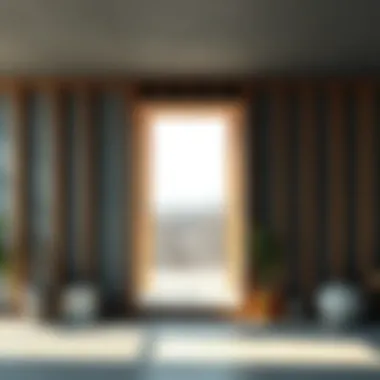
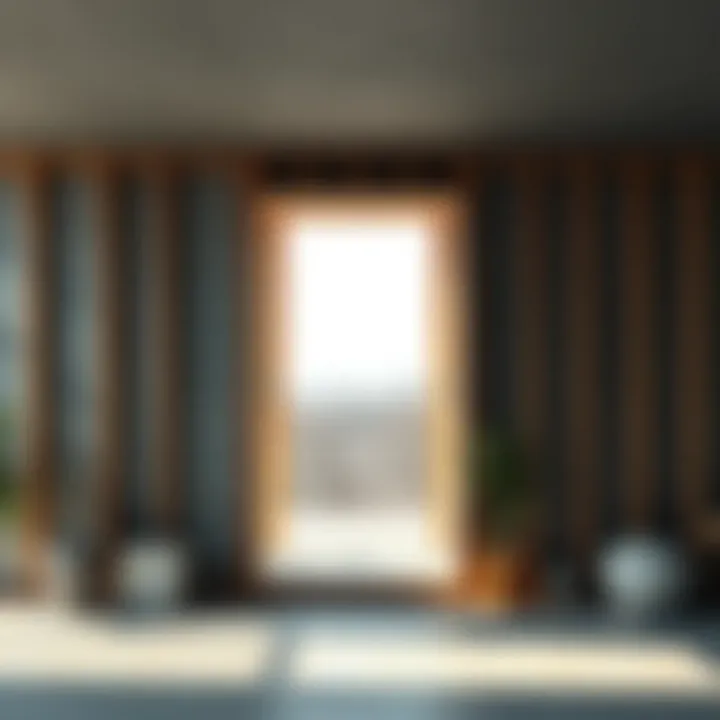
Structural Strength
When it comes to durability, stud frame walls really hold their own. Made primarily of timber or steel, these framing systems provide considerable strength while remaining lightweight. Because they are assembled with vertical studs that are spaced strategically, they can effectively distribute loads, which aids in resisting various forces like wind and earthquakes. Unlike other wall systems, stud frames can absorb movement without buckling, making them practical in diverse regions. This strength is particularly important in areas prone to severe weather.
- Key points on structural strength:
- Load distribution that minimizes structural failure.
- Vulnerability to bending is significantly reduced.
- Performance in seismic zones enhances safety for occupants.
"In a building's life, structural integrity is paramount; stud frame walls deliver that with finesse."
Cost Efficiency
Cost is always a major consideration during the planning of any construction project. Stud frame walls stand out for their affordability. The materials used, especially in timber construction, can often be sourced locally, minimizing transportation costs. Labor is another area where savings can occur; stud wall systems allow for swift assembly, which can significantly cut down on overall labor hours. Moreover, if things need adjusting or changing during the build, the design is often flexible enough to accommodate alterations without hefty fees.
- Breaking down cost benefits:
- Local materials reduce transport expenses.
- Faster construction timelines save on labor costs.
- Easy modifications prevent financial strain during the construction phase.
Design Flexibility
One of the standout aspects of stud frame walls is their remarkable design flexibility. They can be used in a variety of architectural styles, from traditional homes to contemporary commercial buildings. The ability to create larger spaces with fewer interruptions from structural elements allows for open floor plans that many homeowners and businesses crave. Additionally, changes can be made later on, which is perfect for those who prefer to evolve their spaces over time.
- Advantages in design flexibility include:
- Capability of open layouts without obstructive supports.
- Simple alterations lead to a variety of potential layouts.
- Compatibility with numerous exterior finishes improves aesthetic adaptation.
Energy Efficiency
Energy efficiency is another notable advantage of stud frame walls. These walls can be outfitted with a variety of insulation materials, offering superior thermal performance when built correctly. This can lead to lower heating and cooling costs over time, making them an economically wise decision for homeowners. Additionally, with proper ventilation, stud frame walls can help maintain a comfortable indoor climate, enhancing the overall living experience. By investing in energy-efficient insulation, homeowners not only save on future expenses but also reduce their carbon footprints.
- Energy efficiency factors:
- Insulation types can be varied, tailored to specific needs.
- Reduced energy bills make for a smart financial choice.
- Positive environmental impact due to lower energy consumption.
Applications of Stud Frame Walls
Stud frame walls find a variety of applications in both residential and commercial sectors. Their versatile nature lends itself to various building types and purposes. This section will delve into how these walls are employed across different scenarios, examining their benefits and the considerations that come with each.
Residential Construction
In residential settings, stud frame walls are often the go-to choice for new homes, renovations, and additions. They support a structure by creating a framework that can hold up the roof and walls. One noticeable advantage is that they allow for easier modifications compared to traditional masonry walls. Homeowners can reconfigure spaces, add new rooms, or even knock down walls more easily.
- Lightweight and Strong: The combination of lightweight materials such as wood or metal provides structural strength. This makes them easier to handle during the construction process.
- Cost-Effective: Building a new house or renovating an existing one can become quite expensive. Stud frame walls tend to be less expensive than other construction methods, translating into lower overall project costs.
- Aesthetic Versatility: These walls can accommodate various types of finishes, from drywall to paneling. This means homeowners can customize the interior design according to their personal taste.
- Energy Efficiency: Proper insulation between studs also contributes to better temperature control, making homes more energy efficient.
Commercial Projects
In the arena of commercial architecture, stud frame walls are equally impactful. They are extensively utilized in office buildings, retail spaces, and even warehouses. Their modular design allows for quick assembly and disassembly, which can aid in both new constructions and tenant improvements.
- Rapid Construction: The ease and speed of installation can significantly lower labor costs. This is particularly beneficial in commercial projects where time is money.
- Flexibility in Design: Open office layouts, conference rooms, and individual offices can be created without the constraints of traditional building methods. This adaptability makes stud frame walls a favorite among business developers.
- Compliance With Codes: Many commercial buildings are governed by strict building codes and environmental regulations. Stud frame construction can often meet these requirements without excessive material waste.
Renovations and Extensions
For homeowners looking to renovate or extend their properties, stud frame walls are invaluable. They provide a convenient way to modify existing structures without starting from scratch. The lightweight nature of the materials used means that adding a stud frame wall won’t typically overload an existing foundation.
- Easy Installation: The installation process for stud frame walls in renovations is typically less invasive, minimizing disruption to the household. Furthermore, it eliminates the need for heavy machinery to handle the tasks, often resulting in shorter project timelines.
- Integration with Existing Structures: These walls can seamlessly integrate into the existing architecture, ensuring that the aesthetics remain cohesive while achieving improved functionality.
- Cost-Effective Upgrades: Homeowners can add value to their properties without breaking the bank. By restructuring spaces with stud frame walls, they can enhance living areas or create new ones at a fraction of the cost of traditional methods.
Stud frame walls not only facilitate modern construction practices but also adapt well to a variety of needs, proving their worth across multiple applications.
For more insight into effective building practices, visit resources like Wikipedia or Britannica.
If you want to see discussions or tips about stud frames among builders, you can check out forums and posts on Reddit.
Comparative Analysis with Other Wall Systems
When delving into the realm of construction, comparing various wall systems offers clear insights into their specific advantages, limitations, and best-use scenarios. Each type of wall has unique properties that can affect various aspects such as durability, cost, and energy efficiency. This section will explore stud frame walls in relation to other popular wall systems: masonry walls, concrete block walls, and structural insulated panels (SIPs). Understanding these comparisons is essential for making informed decisions in both residential and commercial construction.
Masonry Walls versus Stud Frame Walls
Masonry walls, typically made from bricks or concrete blocks, present a formidable choice in the building arena. Their sturdy nature and resistance to external factors, like weather and fire, are often considered superior to stud frame walls. However, there's a trade-off. Masonry involves a longer build time and generally higher upfront costs.
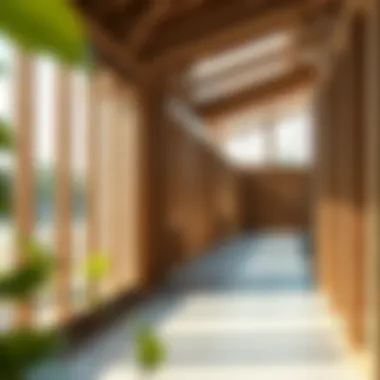
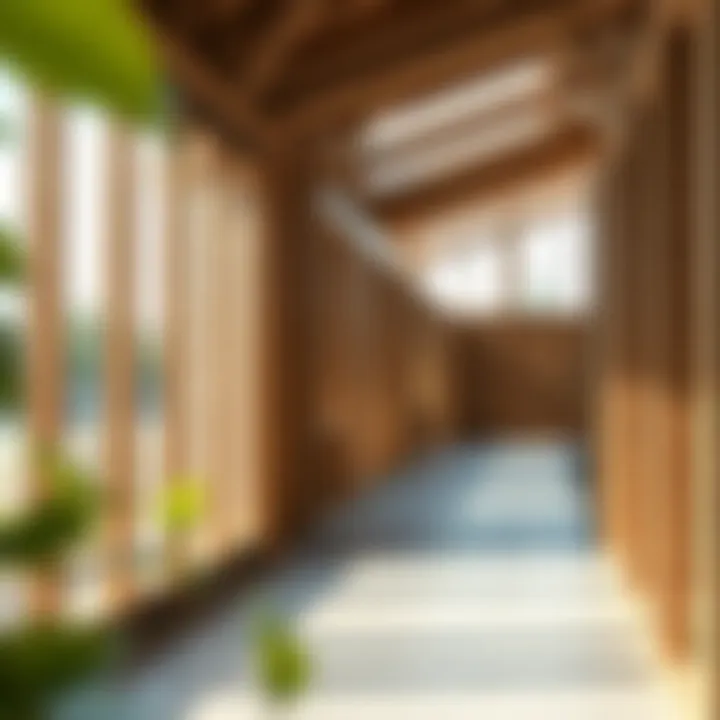
- Advantages of Masonry Walls:
- Drawbacks of Masonry Walls:
- Longevity: With proper maintenance, masonry walls can last decades, perhaps even centuries.
- Fire Resistance: Most masonry materials are non-combustible, providing enhanced safety.
- Sound Insulation: Their dense structure tends to absorb noise better.
- Weight: Heavier than stud frame walls, hence requiring a stronger foundation.
- Lack of Flexibility: Once erected, modifications can be challenging.
In contrast, stud frame walls allow for greater design flexibility and quicker construction times, often appealing to modern architects and builders. With the right insulation and sheathing, stud frame walls can also achieve notable energy efficiency, competing directly with masonry options.
Concrete Block Walls
Concrete block walls, which consist of hollow blocks filled with solid concrete, bring their set of merits and demerits to the table. They combine ease of installation with the benefits of strength and insulation.
- Strength: Known to endure substantial loads, suitable for multi-story buildings.
- Energy Efficiency: When using insulated concrete blocks, these walls can help lower energy costs effectively.
- Fire Resistance: Similar to masonry, they don't burn, providing a fire-safe option.
However, there are significant points to consider:
- Aesthetic Limitations: Their rough, industrial look often limits design possibilities.
- Installation Complexity: While simpler than full masonry, laying blocks requires skill to achieve a strong structure.
Stud frame walls shine in comparison when it comes to adaptability in design and ease of installation, although concrete blocks excel in load-bearing capabilities.
Structural Insulated Panels (SIPs)
As an innovative alternative, Structural Insulated Panels (SIPs) offer a unique approach to wall construction. Made of a foam core sandwiched between two structural facings, they are becoming increasingly popular in energy-efficient designs.
- Insulation Efficiency: The foam core provides exceptional thermal insulation, drastically reducing energy use.
- Speed of Construction: SIPs can reduce labor time considerably as they arrive prefabricated, ready for assembly.
- Strength and Light Weight: They provide good structural integrity without the hefty weight of masonry or concrete blocks.
On the flip side, there are challenges:
- Cost: The initial investment may be higher due to the specialized nature of SIPs.
- Moisture Control: Wiring and plumbing within SIPs requires careful insulation planning to avoid moisture issues.
When you stack SIPs against stud frame walls, it’s important to note that while both offer great thermal efficiency, stud frame walls are generally more customizable and easier to modify post-installation.
The evolution of wall systems continues to shape the landscape of construction, making informed choices crucial for any builder or homeowner.
In summary, each wall system reviewed here holds specific characteristics that can suit various projects. Are you after strength, cost, energy efficiency, or aesthetic appeal? Knowing the strengths and weaknesses of masonry, concrete block walls, and SIPs compared to stud frame walls will arm you with the necessary information to make the right decision for your construction goals.
Installation Process of Stud Frame Walls
Understanding the installation process of stud frame walls is a cornerstone of construction insight. This integral part of building not only requires precision but also a robust understanding of materials and techniques involved. Proper installation ensures that the structures are resilient, meeting both aesthetic and practical needs. This section elucidates vital aspects encompassing planning, required tools, and a step-by-step guide, all of which contribute to a successful stud frame wall assembly.
Planning and Layout
Before one even picks up a hammer, planning is paramount. A well-oriented layout can save time and minimize mistakes, which can be costly both in terms of materials and labor. It's not just about where the walls will go; it involves measuring the space accurately, determining where outlets and windows will be located, and understanding local building codes.
Consider the following elements while planning:
- Room Dimensions: Calculate precise measurements to ensure the stud frame fits snugly within the planned space.
- Design Intentions: What is the room's purpose? This will influence where you place windows, doors, and even how many studs are needed.
- Furniture Placement: Make sure that the future usage of the room is considered in the layout.
- Future Growth: Consider if there may be a need for extensions or additional divisions in the future.
Tip: Always sketch a clear blueprint of your design, making it easier to visualize and communicate ideas!
Tools and Equipment Needed
Equipping oneself with the right tools and materials sets a sturdy stage for successful installation. Having the items laid out minimizes interruptions during the building process.
Here's a checklist to keep you on your toes:
- Measuring Tape: For precision in measuring and ensuring every cut is to spec.
- Circular Saw: Essential for cutting the lumber to size.
- Nail Gun or Hammer: Either will do, but the former speeds things up considerably.
- Level: To confirm that your walls aren’t swaying like a tree in the wind.
- Stud Finder: This gadget helps locate existing studs in the walls if you’re engaging in renovation.
- Safety Gear: This includes gloves, goggles, and a dust mask to protect yourself from debris and dust.
Having the right tools not only fosters efficiency but also enhances the quality of the construction.
Step-by-Step Installation Guide
Now that you have the blueprint and tools ready, let’s roll up those sleeves and get to it. Here’s a methodical approach to installing stud frame walls:
- Mark the Layout: Using your measuring tape, mark where the studs and plates will be positioned on the floor and ceiling using chalk lines.
- Cut the Lumber: Cut your vertical studs and top/bottom plates to the desired lengths, keeping an eye on the measurements.
- Assemble the Frame: Start by attaching the vertical studs to the top and bottom plates using wood screws or nails, spaced properly—typically 16 or 24 inches on center.
- Install the Frame: Position the assembled frame on your marks and secure it to the floor and ceiling. Use the level to ensure everything is plumb.
- Add Sheathing: Attach the sheathing material (like plywood) to the outside of your wall frame. It enhances strength and acts as a foundation for insulation if needed.
- Insulate: Fill the gaps between studs with insulation material to ensure energy efficiency.
- Finish the Walls: Close the walls with drywall, tape the seams, and prepare for whatever wall finish you have in mind.
Guided by this thorough plan, you’ll see that the installation of stud frame walls is a systematic and rewarding process that can lead to a sturdy structure.
"A solid foundation is the key to a good wall, but a well-executed installation is the backbone of durability.”


For more detailed resources, consider checking out Wikipedia or Britannica.
Challenges and Considerations
As with any construction method, stud frame walls come with their own set of challenges and considerations. It’s vital to approach these issues with a keen eye and informed perspective. Ignoring potential pitfalls can lead to costly mistakes down the line. In this section, we will uncover moisture and humidity concerns, sound insulation issues, and the significance of adhering to building codes and regulations. Understanding these elements is crucial for ensuring the longevity, comfort, and safety of the built environment.
Moisture and Humidity Concerns
Moisture is an often underestimated adversary when it comes to stud frame construction. The materials used in this system, while versatile and cost-effective, can be susceptible to damage from humidity and water infiltration.
When moisture seeps into the walls, it can lead to mold growth, decay, and even structural integrity issues. This concern is particularly pronounced in areas with high humidity or rainfall. Utilizing moisture-resistant sheathing products and proper sealing techniques can help minimize these risks.
It’s essential to consider the following strategies:
- Vapor Barriers: Installing polyethylene sheets or similar materials on the interior side of the wall can help prevent moisture migration.
- Proper Drainage Systems: Ensuring that gutters and downspouts direct water away from the foundation reduces the risk of water pooling near stud walls.
- Regular Maintenance: Checking and maintaining gutters, siding, and roofing can spot leaks before they turn into bigger headaches.
"Ignoring moisture problems is like letting a wolf into the henhouse; it’s bound to make a mess and could lead to disaster down the road."
Sound Insulation Issues
Another challenge of stud frame walls is their sound insulation quality. For residential or commercial applications, achieving adequate soundproofing often becomes necessary, depending on the intended use of the space. Traditional stud frame construction doesn’t provide the same level of sound insulation as heavier wall systems like masonry.
To enhance acoustic performance, consider the following approaches:
- Insulation Type: Utilizing soundproofing insulation such as mineral wool or specialized acoustic batt can make significant improvements.
- Double Stud Walls: Building two parallel stud walls with a gap in between can drastically diminish sound transmission.
- Damping Materials: Applying materials designed to dampen sound, such as resilient channels or soundproof drywall, can also be effective.
Balancing the need for sound insulation with cost and space considerations can be tricky, but a little foresight can go a long way.
Building Codes and Regulations
Compliance with building codes is non-negotiable. These codes are set in place not just for aesthetics but also for safety. Stud frame construction must adhere to local, state, and federal regulations. This can vary significantly by location and type of structure being built. Builders who skip this step might encounter legal troubles or have to make costly adjustments later on.
Key aspects to keep in mind include:
- Local Amendments: Different regions may have specific regulations concerning seismic, wind, or snow loads, which may necessitate additional engineering considerations for stud frame walls.
- Energy Codes: Many areas enforce energy efficiency standards. Builders must ensure that insulation and other systems within the wall meet these criteria to improve energy use in the long run.
- Permits and Inspections: Securing the necessary permits and undergoing inspections is pivotal. Builders should be prepared for this process by keeping accurate documentation.
In summary, approaching these challenges comprehensively can protect the investment in stud frame construction. Recognizing and strategically addressing moisture, sound insulation, and code compliance creates a sturdy and reliable built environment.
Future Trends in Stud Frame Construction
As the world steers towards a more sustainable and innovative construction landscape, stud frame walls are increasingly in the spotlight. The significance of exploring future trends in stud frame construction lies not just in the evolution of building practices, but also in addressing the broader questions of sustainability and efficiency. Light-frame construction methods allow for both versatility and adaptability, which is essential as we confront changing environmental conditions and shifting architectural preferences.
Emerging materials and evolving technologies are setting the stage for stud frame walls to embrace an upgraded future. The incorporation of these elements can significantly enhance the structural integrity and functionality of buildings, catering to a variety of user needs and environmental challenges.
Innovative Materials and Technologies
The construction industry has witnessed a surge in innovative materials aimed at improving the performance of stud frame walls. Today, builders are turning to engineered wood products like cross-laminated timber (CLT) and laminated veneer lumber (LVL). These materials not only provide greater strength than traditional wood but also can be sourced sustainably. The use of advanced composites, such as fiberglass and carbon-fiber reinforcements, is also gaining traction, promising lighter yet stronger wall assemblies.
Technologies such as Building Information Modeling (BIM) are transforming traditional construction practices, allowing for enhanced collaboration among architects, engineers, and builders. This digitally-driven process minimizes mistakes and streamlines the design and installation phases, ultimately saving time and reducing costs. Additionally, prefabricated wall panels are gaining momentum, as they allow for quicker on-site assembly and less waste, aligning with both efficiency and sustainability goals.
"Innovations in material science and technology are poised to reshape how we design and construct stud frame walls, paving the way for smarter building practices."
Sustainability in Building Practices
Sustainability is no longer just a buzzword; it’s a core principle that's reshaping construction practices everywhere. The future of stud frame walls is closely linked to these sustainable practices. By opting for eco-friendly materials and methods, builders can significantly reduce their carbon footprint. For instance, the use of recycled or repurposed materials in stud framing reduces waste and encourages resource efficiency.
Additionally, energy-efficient insulation materials are being integrated more frequently into stud frame designs. These advancements not only enhance the thermal performance of buildings but also contribute to lower energy costs for homeowners. Targeting net-zero energy homes, where the energy consumed is equal to the energy produced, is becoming a frontier in residential building design, with stud frame walls playing a critical role.
Incorporating green building certifications like LEED (Leadership in Energy and Environmental Design) also reflects a growing emphasis on environmental responsibility in construction. As consumers become more environmentally conscious, builders who prioritize sustainability through stud frame construction will likely gain a competitive edge in the marketplace.
The End
In wrapping up this exploration into the realm of stud frame walls, it is essential to highlight what truly sets this construction method apart. Whether it's the strength they provide or the cost savings to be had, stud frame walls have carved out a respectable niche in both residential and commercial applications. Their lightweight nature and adaptability allow for a myriad of architectural possibilities that cater to varying needs.
Recap of Key Points
- Definition and Overview: Stud frame walls are a popular choice across various constructions, known for their efficient design and practicality, blending structure with aesthetics.
- Components of the System: From vertical studs to sheathing materials, understanding each element is critical for maximizing the benefits of stud frame walls.
- Advantages: Important benefits include cost efficiency, structural strength, and flexibility in design, as well as their contribution to energy efficiency—especially with the right insulation.
- Applications: These walls are not just for new builds; they find their place in renovations and commercial projects too, showcasing their versatility.
- Comparative Analysis: By contrasting with masonry, concrete block, and structural insulated panels, we see clearly how stud frame walls hold unique advantages for specific scenarios.
- Installation Process: Knowing the steps involved in properly installing these walls is vital, as proper execution can prevent future issues.
- Challenges: It’s important to stay aware of potential moisture and sound insulation concerns, alongside navigating the necessary building codes.
- Future Outlook: With ongoing advancements in materials and methods, the future of stud frame construction appears promising and increasingly aligned with sustainability goals.
Final Thoughts on Stud Frame Walls
In consideration of all these elements, one realizes that stud frame walls are not merely a construction choice but rather a multifaceted solution for modern architecture. Their alignment with energy efficiency adds to their appeal, especially in today’s environmentally conscious climate.
As you journey into the world of residential and commercial design, understanding the ins and outs of stud frame walls can empower your decision-making immensely. They offer durability, adaptability, and a smart approach to constructing spaces that are not only practical but also visually appealing.
Ultimately, whether you are a homeowner, builder, or architect, stud frame walls present an opportunity to create spaces that fulfill both functional and aesthetic demands. For those interested in exploring more, resources from sites like Wikipedia, Britannica, or community discussions on platforms like Reddit can provide further insight and updates on evolving practices.















